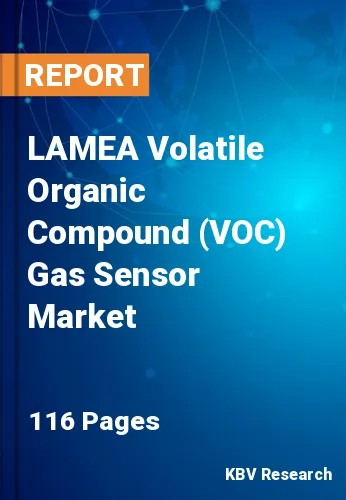The Latin America, Middle East and Africa Volatile Organic Compound (VOC) Gas Sensor Market would witness market growth of 8.5% CAGR during the forecast period (2023-2029).
Electronic gas sensors that are very sensitive, flexible, and foldable are gaining a lot of interest from manufacturers due to their potential usage in wearable electronics applications. The development of wearable gas sensors for real-time, extremely sensitive, and targeted identification of dangerous gases at Room Temperature (RT) is reviewed using carbon nanoparticles, 2D nanomaterials, conductive polymers, and composites. These sensors can be integrated into consumer goods or body-worn textiles, as well as laminated onto an individual's body. The potential to monitor health, public safety, environment, security, and food quality with wearable gas sensors is very high.
The human senses cannot detect several hazards, including combustible gases, toxic gases, low oxygen levels, and vapors. All these dangers represent a significant danger to both plant safety as well as human life in numerous industrial industries. As poor air quality has a detrimental effect on society's health and economy, managing environmental gas pollution has become essential.
Latin America is rich in mineral resources, including copper, gold, silver, iron ore, bauxite, and lithium. The region's geological makeup and diverse landscape have created favorable conditions for depositing these resources, making them attractive for mining activities. Regional integration initiatives, such as the Pacific Alliance and Mercosur, have promoted intra-regional trade and investment, creating a larger market for mineral exports. Trade agreements with other countries and regions have also facilitated access to international markets, boosting the export potential of Latin American mining products. Therefore, as the regional oil & gas and metals & mining sector expand in the region, it will propel the advancement of the regional market.
The Brazil market dominated the LAMEA Volatile Organic Compound (VOC) Gas Sensor Market by Country in 2022 and would continue to be a dominant market till 2029; thereby, achieving a market value of $4,188.4 Thousands by 2029. The Argentina market is poised to grow at a CAGR of 9.1% during (2023 - 2029). Additionally, The UAE market would witness a CAGR of 8.2% during (2023 - 2029).
Based on Type, the market is segmented into Multiple Gas Detection Sensor and Single Gas Detection Sensor. Based on Application, the market is segmented into Oil & Gas, Agriculture, Manufacturing, Chemical Industry, Automotive, Metals & Mining, Food & Beverages, and Others. Based on Technology, the market is segmented into Metal-oxide Semiconductor, Infrared-based Detection, Photo-Ionization Detector (PID) and Others. Based on countries, the market is segmented into Brazil, Argentina, UAE, Saudi Arabia, South Africa, Nigeria, and Rest of LAMEA.
Free Valuable Insights: The Worldwide Volatile Organic Compound (VOC) Gas Sensor Market is Projected to reach USD 216.1 Million by 2029, at a CAGR of 5.3%
The market research report covers the analysis of key stake holders of the market. Key companies profiled in the report include Honeywell International, Inc., Siemens AG, Alphasense, Inc., Bosch Sensortec GmbH (Robert Bosch GmbH), ABB Ltd, Renesas Electronics Corporation, Sensirion AG, Interlink Electronics, Inc. (KWJ Engineering, Inc.), SGX Sensortech (Amphenol Corporation), and ION Science Ltd.
By Type
By Application
By Technology
By Country
Our team of dedicated experts can provide you with attractive expansion opportunities for your business.

